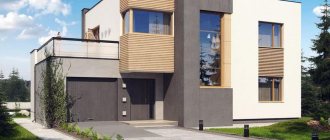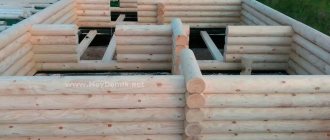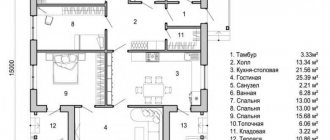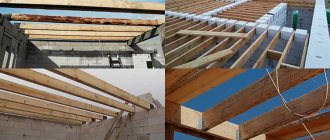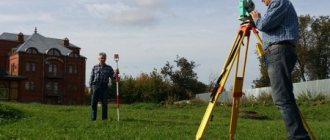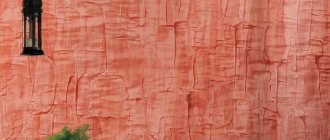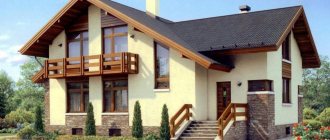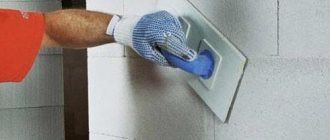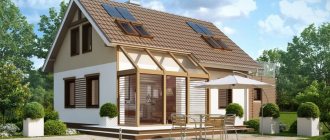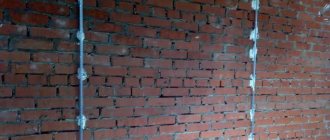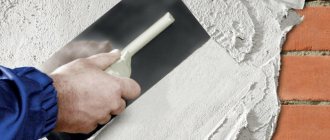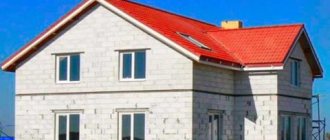Features of aerated concrete
The construction market is saturated with different types of blocks, which are popular due to their unique characteristics. Gas silicate or aerated concrete blocks, filled with expanded clay or polyurethane foam - these are all materials of the same type, but with different strength and heat-saving abilities.
Aerated concrete is often used to build walls
All elements have standard sizes, they are more economical when constructing walls than brick and are not subject to rotting like wood.
The main differences between these materials are the composition and the presence of additional fillers. Aerated concrete blocks are made from Portland cement and sand, and
azosilicate - based on lime and silica mixture, which gives the same characteristics to finished products as cement.
Building materials of this type are characterized by low thermal conductivity and resistance to humid environments, but the porous structure requires mandatory surface treatment.
Plastering aerated concrete is a mandatory process that eliminates the accumulation of moisture in the porous structure of the blocks and gives walls with a not very smooth surface an aesthetic appearance. Finishing includes a whole range of works that increase the service life of buildings. Plastering walls made of gas silicate blocks or aerated concrete is no different. Building materials have an identical surface structure and are subject to the same processing.
Priming is an important stage in preparing the surface of walls for plaster.
Regardless of the methods of subsequent finishing, as well as whether the work is carried out indoors or outdoors, priming of aerated concrete and foam concrete blocks is a necessary step. Primers are used to obtain the following effects:
- Reducing and leveling water absorption of the base. Any primer composition contains polymer fillers. Penetrating into the structure of the blocks, they bind to the base and compact it. This reduces the ability to absorb moisture and liquids.
- Strengthening the adhesive ability of walls. Porous blocks and drywall, due to high water absorption, are characterized by low adhesion ability. Priming the walls before plastering can slightly improve the adhesion strength of the mortars.
- Dust removal of the surface. The presence of a large number of small fractions of sawdust and sand on the treated surface negatively affects adhesion. This can even lead to peeling of the applied hardened layer. Priming will bind the particles and give the surface an adhesive structure.
What primers are used for aerated concrete and foam blocks before applying plaster?
For highly absorbent substrates, it is most rational to use either universal or deep penetration primers with the property of reducing the moisture absorption of materials. We recommend using the following types of primers for preparing walls made of gas silicate block, foam block, and other cellular concrete:
- Primer Ceresit CT 17 deep penetration. It is used on all types of highly absorbent substrates, strengthens, evens out water absorption, and enhances adhesion. Due to the pigments in the composition, when applied, it leaves a light tone. It allows you to visually identify gaps for the highest quality and uniform surface treatment. Interlayer drying - up to 30-40 minutes, complete drying in 2-4 hours (at room temperature).
- Primer Eunice for interior work. It is used for processing and preparing walls indoors. The composition based on acrylates perfectly levels out moisture absorption and binds dust (removes dust from the surface). Recommended for application to walls made of cellular concrete blocks and plasterboard. Interlayer drying - up to 40 minutes, complete drying - 3 hours.
- Ceresit façade primer ST 16. Specialized polymer-based composition with anti-frost additives. Ideal for priming external walls before applying decorative plaster. Can be used for interior work before subsequent finishing putty. Interlayer drying - up to 30-40 minutes, complete drying - 3 hours (at a temperature of 18-25 degrees).
- Primer Knauf Mittelgrund F. Concentrated composition based on polymer binders. Has a high ability to level moisture absorption. The composition contains a yellow pigment to visually determine the quality of application to the surface. It is recommended to dilute with water in a ratio of 1k5 (foam concrete and aerated concrete) and 1k3 (plasterboard). The primer has the property of frost resistance. It can be used when preparing walls before façade finishing. Complete drying - up to 6 hours.
There is a type of primer called concrete contact . It is not recommended to use it on porous, highly absorbent substrates such as foam concrete or aerated concrete . During the drying process, it forms a film that does not have sufficient adhesion to such materials.
Technology for applying primers before plastering and filling gypsum plasterboard, aerated concrete, foam concrete
It is recommended to apply primer to aerated concrete and foam concrete in at least 2-3 layers. GKL - no less than 1-2 layers. Each layer should be generous. This is important to achieve the best effect.
Manual and mechanized means can be used for application. Suitable:
- brush-brush;
- roller;
- sprayer for flowerpots;
- garden sprayer.
To treat a large surface area of the walls, you can also use a spray gun, which will significantly speed up the preparation process.
Before each subsequent layer, it is necessary to wait a technological pause - allow the surface to absorb the solution and dry. Pay attention to the recommendations of the primer manufacturer, namely, the time of interlayer drying and complete drying.
Further work should be started only after the recommended period of complete drying has passed. A completely dried layer guarantees high-quality polymerization of the composition in the structure of the blocks and the set of required qualities by the base.
Advantages of plastering aerated concrete walls
This type of finishing is universal; it is used both indoors and on building facades. Plaster does not change the basic properties of the blocks and creates protection from moisture, mechanical damage and additionally increases the heat and noise insulation characteristics.
Covering the walls with mortars will be the basis for subsequent finishing; high leveling properties create an even base on the surface for wallpapering or painting. Materials in the form of tiles will adhere better to plastered surfaces than to aerated concrete. Finishing improves the appearance of buildings unless other types of cladding are provided to cover the walls.
Fact!
The coating protects the porous structure of the block from rain, which during cold periods can crystallize inside and destroy the building material.
Plastering is an inexpensive and effective way to protect aerated concrete walls
Plaster options
Is it necessary to plaster aerated concrete blocks on the inside of a building? With the interior finishing of the walls, the vapor permeability of aerated concrete is maintained and increased. The finishing also helps create an optimal indoor microclimate. It remains to be seen what is better and how to plaster the internal walls.
Cement-sand mixture
It is not advisable to use cement-sand mortar for plastering aerated concrete masonry. There are several reasons:
- The vapor permeability of cement mortar is significantly lower than that of cellular concrete. To create an optimal microclimate in a house made of aerated concrete walls, it is necessary to choose a finishing material with vapor permeability equal to or slightly higher than that of artificial stone. If the moisture absorption coefficient has significant differences, then aerated concrete will absorb moisture from the cement-sand based solution. As a result, the quality of the plaster will decrease and cracking and crumbling areas will appear on the walls. The main condition for achieving optimal strength parameters is the uniform and gradual drying of cement plaster. If there is no barrier with a wall, this condition will not be met.
- The solution has low adhesive properties and high specific gravity, which eliminates the possibility of strong and reliable adhesion of the finishing material to the working surface.
Plaster
When plastering aerated concrete walls inside a house with a gypsum compound, both positive and some negative aspects are observed. The main advantages are:
- Quick drying of the applied layer.
- High rates of plasticity.
- No shrinkage changes.
- The ability to create a perfectly smooth and even surface.
- Simplicity of the workflow. Due to the smooth surface of aerated concrete walls, the mixture can be applied without a finishing layer. But this option is suitable for wallpapering walls. Subject to further tinting, a finishing layer is indispensable.
The gypsum composition has some disadvantages:
- Low vapor permeability.
- A large volume of water is required when mixing the mixture.
- High adhesion rates.
Gypsum mixture for interior work is suitable for creating a finishing layer on aerated concrete masonry. This material is used only in dry rooms. But when treating the working surface with special means that resist the effects of a humid environment, the gypsum mixture can be applied to the walls of the bathroom, basement, open balconies, etc.
Facade
This type of plaster mixture is optimal for finishing aerated concrete masonry. Can be used both indoors and outdoors. The vapor permeability of the materials fully corresponds to the indicators of the cellular block. In addition, they have high adhesive properties and are distinguished by good aesthetics after complete drying.
Basic requirements for plaster
Interior plaster for aerated concrete must meet many requirements that must be taken into account when purchasing materials. The characteristics of solutions for walls made of aerated concrete from the outside and inside are almost identical, but to protect external surfaces, additional resistance to cyclic freezing is required during the operation of buildings in winter.
Basic requirements for plaster for gas silicate blocks:
- vapor permeability (the vapor permeability coefficient must be at least 0.11 mg/m∙h∙Pa for aerated concrete with a density of 1000 kg/m3 and 0.14 mg/m∙h∙Pa for aerated concrete with a density of 800 kg/m3);
- good adhesion to aerated concrete (adhesive strength of at least 0.4 MPa);
- compressive strength, preventing the appearance of cracks on the surface during the operation of buildings;
- resistance to moisture and mechanical damage;
- the viability of the solution is at least 60 minutes, otherwise the porous structure of the material will not provide proper adhesion to the base.
Most mixtures have these characteristics, but it is worth considering that finishing materials have different purposes. There are compositions for use in rooms with high and variable humidity, dry living rooms, or intended for performing facade work.
Vapor permeability and humidity balance
If plastering of aerated concrete walls was carried out using heavy cement mixtures, it is important to ensure proper ventilation. The best solution would be forced exhaust systems. They allow you to remove excess moisture.
If the aerated concrete surface is protected from the outside by a ventilated façade system, a gap is provided to allow vapors from the room to freely escape outside. This allows you to use different types of plaster for aerated concrete without fear of disturbing the vapor permeability parameters. Do not use foam for protection. It has almost zero vapor permeability. Mineral wool will do.
If you want to balance the humidity, then when finishing the interior, use materials with a vapor permeability lower than that of the blocks. These can be special hydrophobic impregnations, paints, compositions with a dense consistency or moisture-resistant wallpaper. However, in this case, the importance of arranging high-quality ventilation increases. Otherwise, a greenhouse effect will occur.
Vapor permeability of plaster for aerated concrete
Aerated concrete is a lightweight porous material with a unique property such as vapor permeability. This property allows the walls to “breathe” and prevents the accumulation of moisture inside the wall, which affects the indoor microclimate.
The vapor permeability indicator depends on the density of aerated concrete, for example:
- for a density of 800 kg/m3. – 0.14 mg/(m h Pa);
- for a density of 900 kg/m3. – 0.12 mg/(m h Pa);
- for a density of 1000 kg/m3. – 0.11 mg/(m h Pa).
Important!
The higher the density of the gas block, the lower its vapor permeability.
Facade plaster for aerated concrete must be weatherproof
In the process of leveling walls, it is important to use special grades of plaster in order to maintain the performance characteristics of aerated concrete. If we neglect this, then the heat-insulating and vapor-permeable properties will sharply decrease.
Undesirable consequences of reduction:
- formation of cracks on the internal plaster and on the facade;
- increased humidity levels in the room, stains on the walls;
- formation of fungus and mold.
When choosing mixtures in a store, pay attention to the vapor permeability coefficient of plaster for aerated concrete walls. A good indicator would be something close to the building block. This way the walls will “breathe” and not accumulate moisture.
How to increase it
Ready-made mixtures that are sold in stores contain all the necessary components that provide the desired characteristics, but if the solution is prepared independently, then you need to buy additional additives.
To increase the vapor permeability of plaster, there are special additives. For example, consider the additive Ceresit CO 84. It is used for cement-sand plasters and allows you to increase the porosity of the plaster up to 25%. Thus, with its help it is possible to modify a conventional cement-sand mixture, thereby giving it the required vapor permeability characteristics.
How to plaster aerated concrete
How to plaster aerated concrete walls inside a house? There is no clear answer to this question. If you buy ready-made plaster mixtures, then there are no problems other than the financial component. Dry plaster on various bases is always available for sale:
- lime and cement - the most popular mixture for plastering aerated concrete walls;
- liquid glass (silicate mixture) - the cheapest type of dry mortar, but incompatible with decorative plaster based on acrylic, silicone, latex;
- silicone - the highest quality plaster mixture with, naturally, the highest price;
- cement and mineral chips that replace sand.
For reference: there are also acrylic mixtures on sale, but they are best used for decorative plaster.
Buying ready-made plaster will seriously affect the family budget, so you need to consider options for preparing the solution yourself. So which plaster is better for plastering aerated concrete walls? There are two blocks of answers here, depending on the type of prepared adhesion between the wall and the plaster.
- The plaster mortar is applied directly to the wall, pre-treated with a penetrating primer with the slots cut with a chainsaw (the slots are necessary for better adhesion of the mortar to aerated concrete).
- Plastering the wall is done using a plaster mesh mounted on a special glue, which has become fashionable lately.
In the first case, it is necessary to take into account the characteristics of the material:
- the presence of cement and lime components;
- porosity;
- high vapor permeability.
This unusual combination of properties near the wall immediately removes cement mortar and sand from the list of mixtures. It adheres very poorly to such a surface, even when applying a high-quality primer.
Here you need to use:
- gypsum with light perlite sand;
- gypsum with lime;
- lime with cement, fine sand, aggregates and plasticizer.
In the second case, any combination of mortar components is allowed, including cement and sand in a ratio of 1 to 5.
Which plaster is better for plastering aerated concrete walls?
There are a large number of aerated concrete mixtures on the market for interior and exterior use. Gypsum and cement plasters are mainly used. These varieties have their own areas of application and their own performance characteristics.
If the house is new, then there is no need to rush to plaster the premises. For the first time in six months, the building is shrinking. If you neglect this feature, the protective layer will quickly crack and become fragile. It is recommended to plaster a house made of aerated concrete blocks at least 6 months after construction.
Several types of plaster mixtures are suitable for processing aerated concrete slabs
Mineral
A universal composition of a mixture of lime, fine sand, cement and stone chips or dust. It has good adhesion to the base, but dries quickly, so plasticizers are often added to the solution to slow down the setting of the surface. Mineral plaster is applicable in any premises and on the facades of buildings. More often it is used as a finishing coating, after leveling the walls with cement mortar.
Silicate
It is made on the basis of liquid glass. Silicate plaster has good vapor permeability and sufficient plasticity; when drying, cracks do not form on the coating.
The material is not static, so it does not attract dirt and dust. It is also universal in application, can be used for finishing facades, wet rooms and dry living rooms. The silicate mixture has a complex composition, so it is often sold ready-made to avoid disruption of the mixing technology.
Silicone
Silicone plaster is the most expensive, but it has all the necessary characteristics necessary for plastering aerated concrete blocks. The mixture creates a durable layer on the surface that can last more than 25 years.
If finishing is carried out on the walls of a house that has not gone through the shrinkage process, it makes sense to use this material. It does not shrink and retains its original properties regardless of the conditions of use.
Acrylic
Acrylic is made on the basis of resins and plasticizers. Creates a durable elastic layer on the surface that can protect against negative factors and moisture. This plaster is rarely used as a leveling base, but is used as a finishing wall with decorative effects.
Cement-sand
Cement plaster is used to level aerated concrete walls in wet areas such as bathrooms and kitchens. The surface of the wall on the side of the wet room should not allow moisture to pass through and cause the aerated concrete to become wet. Gypsum plaster is not suitable for covering aerated concrete in a bathroom, as it is not moisture resistant. Cement plaster, on the contrary, copes with this task perfectly.
This type of mortar is also used for plastering facades made of aerated concrete; it has sufficient strength and resistance to precipitation.
Many novice finishers wonder whether it is possible to plaster an aerated block with cement plaster in dry rooms. The answer is no. Conventional cement mixtures cannot be used in dry rooms, as they have low vapor permeability. Thus, the plaster prevents air exchange in the pores of the aerated block and creates conditions for the accumulation of moisture.
Gypsum solutions are widely used for interior finishing of aerated concrete.
Lime-cement
Lime-cement is one of the most popular mixtures for wall finishing. The solution is quite plastic and creates a durable layer when applied to the surface. To give additional characteristics, plasticizers are introduced into the composition, which provide moisture resistance and are able to withstand strong temperature changes.
You can plaster the surface with lime-cement mixtures yourself. The permissible application layer is 5-20 mm; with a minimum value, reinforcement may not be used if the work is carried out indoors.
Plaster
Gypsum plaster is ideal for leveling aerated concrete walls in dry rooms. All brands of gypsum plaster have good vapor permeability and heat-insulating properties, are plastic, easy to apply to aerated concrete wall surfaces, and have good adhesion. Other advantages include low weight, no shrinkage and short drying time.
For your information!
If we take into account the fact that aerated concrete has an ideal geometry, then the consumption of plaster will be economical with a leveling thickness of 3-5 mm.
When to start plastering interior walls
After constructing the box of the house, which includes the walls and roof, you need to wait at least half a year before finishing the interior. The thing is that fresh factory autoclaved aerated concrete is very wet, the proportion of water in it can be 30%.
To begin finishing work, aerated concrete must shrink and dry enough so that most of the moisture has time to disappear.
It is recommended to carry out internal plastering no earlier than 6 months after the completion of the construction of the frame of an aerated concrete house.
External finishing and insulation are recommended to be done after interior work and outside the heating season. But if this is a system with a ventilated facade, then, in principle, it does not matter when to do it, since the ventilation gap between the aerated concrete and the cladding will not prevent water vapor from escaping from the thickness of the aerated concrete.
Always remember the rule: the vapor permeability of the outer layers should be higher than the inner ones, so the aerated concrete wall will always be dry.
Most popular manufacturers
To perform work on aerated concrete surfaces, there are enough mixtures to do the work yourself without losing quality. Manufacturers provide a wide selection of both universal compositions and a narrow focus: for interior work and dry rooms.
In order not to make mistakes with the finishing, you should pay attention to solutions with a wide range of uses. They are sold in the form of a dry powder that needs to be diluted, or ready-made.
Popular manufacturers are the following brands: Volma, KNAUF, Weber, Bolars, Ceresit and Osnovit, while there are little-known companies on the market that offer their products with decent quality.
There are quite a lot of plasters suitable for aerated concrete, and the choice should be based on cost, area of application and technical characteristics of the material.
Plaster mixtures for finishing aerated concrete are available in the product lines of all major plastering manufacturers
Types of putty for gas block
Puttying of aerated concrete walls is carried out using various materials. The choice of putty composition depends on the purpose - for interior or facade work, finishing coating, conditions of use, skill of the finisher, budget. We offer a brief overview of materials that will help you choose how to putty aerated concrete inside and outside the house.
Cement based
The cement-based mixture is universal, suitable for exterior and interior use. In addition to cement, the aerated concrete putty contains polymer additives that ensure the ideal smoothness of the treated surface. For external work, a mixture with thermal insulation additives can be used. The cement mixture for puttying aerated concrete blocks is sold dry (in paper bags) or liquid (in plastic buckets).
Specifications:
- type - start and finish;
- fraction size - from 0.1 to 3 mm;
- maximum layer thickness - 3-5 mm;
- solution viability - up to 90 minutes;
- operating temperature - from +5 to +30°C;
- hardening time - 28 days.
The advantage of plastering aerated concrete walls without plaster using a cement mixture is its low price. Applying a leveling layer is quite difficult. We'll talk about how to putty walls made of aerated concrete below.
Adhesive based
The putty mixture contains environmentally friendly PVA glue, which ensures high adhesion. Chalk or talc is used as a filler. For easy application, drying oil is added to the adhesive putty for gas blocks.
The material is distinguished by its reasonable price, ease of application, and excellent performance properties. Specifications:
- type - start and finish;
- fraction size - from 0.1 to 2 mm;
- maximum layer thickness - up to 2 mm;
- solution viability - up to 120 minutes;
- operating temperature - from +15 to +35°C;
- hardening time - 24 hours.
Please note that adhesive-based material can only be used for interior work. Therefore, if you do not have enough experience in finishing and are looking for something to putty on walls made of aerated concrete blocks inside, we recommend that you pay attention to this option.
Expert opinion Vitaly Kudryashov builder, aspiring author
Ask a Question
Another important fact: the adhesive mixture is applied in only 1 (!) layer with a thickness of no more than 2-3 mm. A thicker layer will crack and the finish will become unusable. Puttying the aerated block with an adhesive mixture is possible only if there are minimal irregularities.
Gypsum based
The putty contains gypsum, which has a coarse fraction. Therefore, gypsum putty on walls made of aerated concrete is a starting material. The material is suitable for interior and exterior work for preparing aerated block walls for wallpaper and other types of decorative finishing. The disadvantage of the gypsum putty mixture is that it is necessary to grind the surface.
Specifications:
- type - starting;
- fraction size - from 0.5 to 5 mm;
- maximum layer thickness - 1-5 mm;
- solution viability - 20-30 minutes;
- operating temperature - from +5 to +40°C;
- hardening time - from 45 minutes to 2-3 hours.
Internal gypsum putty of aerated concrete without plaster quickly sets, forming a dense monolithic layer of high strength. To apply the material, work experience is required: the master has no more than 3-5 minutes to level the mixture before setting begins. Therefore, when choosing how to putty aerated concrete inside the house, take this feature into account and, if you lack experience, buy another material.
Oil based
Contains glue, acrylates, plasticizers and water. Drying oil is used as an oil base. Puttying aerated concrete with this composition is only possible indoors before painting with oil paint. This type of leveling solution has low adhesion to wallpaper adhesives, acrylic paints, and vinyl. Therefore, the scope of application of oil putty for aerated concrete blocks is limited. At the same time, the oil-adhesive mixture is easy to apply and dries quickly. The disadvantages of the material are: high hygroscopicity, low resistance to mechanical damage.
Specifications:
- type - start and finish;
- fraction size - from 0.1 to 2 mm;
- maximum layer thickness - up to 2 mm;
- solution viability - up to 1 year;
- operating temperature - from +15 to +35°C;
- hardening time - up to 24 hours.
Oil putty is easily leveled on the wall, so it can be recommended for use by those who have minimal experience in finishing work. When choosing this material, you need to take into account that puttying of aerated concrete should be carried out at air humidity no higher than 85%. At high humidity, the adhesive properties of the oil composition are reduced and the leveling layer does not lay down evenly.
Polymer based
Environmentally friendly, universal putty composition for external and internal work. When hardened, the polymer putty on the gas block has a fine-grained structure. The surface is easy to sand and does not crack or shrink. Can be used for any type of final finishing. If you are looking for how to putty aerated concrete inside and outside the house, then we can say with confidence that you won’t find a better option. Polymer putty has high adhesion, resistance to mechanical damage and climatic factors.
Specifications:
- type - start and finish;
- fraction size - from 0.1 to 3 mm;
- maximum layer thickness - up to 5 mm;
- solution viability - from 1 to 24 hours;
- operating temperature - from +5 to +35°C;
- hardening time - up to 24 hours.
Polymer putty on aerated concrete blocks without plaster allows you to create an even preparation for wallpaper or painting without any extra effort. Polymer-based aerated concrete putty is applied in exactly the same way as cement putty. The only drawback of the material is the relatively high price.
Optimal conditions for applying plaster
The technological process of applying solutions to surfaces prohibits work in direct sunlight, in windy weather and at temperatures of 10 degrees and below. At minus values, additional frost-resistant components are introduced into the mixture, but it is better to plaster the facade of a house made of aerated concrete at a temperature of +5-25 degrees and a humidity of up to 75-80%. Indoor plastering adheres to the same conditions, which provide sufficient time for the solution to adhere to the surface. The optimal time for applying solutions to interior walls is spring, when there is good humidity in the air and the temperature is not too high.
When carrying out work that does not comply with normal conditions, the likelihood of cracking and peeling of the coating from the base increases. This will manifest itself in the first winter of operation of the building.
Interior decoration of aerated concrete house
Currently, there are a large number of ready-made dry mixtures for plastering walls. When choosing a material for plastering work, the following factors must be taken into account:
- The plaster mixture must have good vapor permeability parameters, at least equal to those of aerated concrete;
- Excessive amounts of water should not be used to prepare the working mixture.
- The selected mixture must have a high coefficient of adhesion to the base;
- The plasticity of the plaster should provide the walls with resistance to cracks;
- The frost resistance of the selected mixture must correspond to climatic conditions;
- The time before the newly prepared mixture begins to set, in other words, the time during which the prepared mixture has sufficient plasticity for application to the base.
Currently, in the market of dry mixes for plastering aerated concrete, with a huge variety of choices, in terms of price-quality ratio, Ceresit CT 24 confidently leads.
In conclusion, I would like to remind you that regardless of what you use to plaster aerated concrete, compliance with the technological regimes specified by the contractor of the plaster mixture is directly related to the quality and durability of the work performed. The preparation of the foundation should not be neglected. Preliminary removal of various irregularities in the masonry will allow you to significantly reduce the layer of plaster applied to aerated concrete, and, consequently, its consumption.
When can I plaster after masonry?
In most cases, it is recommended to plaster the interior first. As a rule, aerated concrete already contains water vapor. The base becomes even more moistened when the plaster is applied, and the wall partially absorbs water from the mortar. Accordingly, it is necessary for this water to evaporate as soon as possible. And the easiest way for it to evaporate is through the outer blown surface of the wall. Therefore, work begins with the inner wall, so that moisture moves towards the outer wall.
If you neglect this rule and plaster the facade first, the accumulated moisture will not be able to quickly evaporate and will begin to move towards the inner surface of the wall. Then, when the interior plaster is completed, the surface will be further moistened thanks to the solution. In cold weather, condensation will form under the interior plaster, causing peeling and cracking.
On a note!
The exception is houses located in close proximity to rivers, lakes, and seas. In this case, it is necessary first of all to protect the outer surface from moisture and wind.
The façade of aerated concrete houses should be plastered last.
Exterior finishing of aerated concrete
First, let’s talk about how you can’t trim. You cannot insulate with polystyrene foam or expanded polystyrene, plaster the outside with ordinary sand-concrete plaster, or paint with covering film-forming paints. If necessary, you can use mineral wool as insulation and paint it with paints that do not block the pores for moisture to escape from the wall. Now let’s talk about how to finish a foam concrete façade.
Curtain facades: lining, siding, panels, etc.
When finishing with any materials that are mounted on the sheathing or guides, a gap remains between the finishing material and the wall. It is called ventilation, since in this gap, with the correct design, there is active movement of air from bottom to top. The correct device is the presence of holes in the finishing material at the bottom and top. This ensures the movement of air flow from bottom to top. This flow carries away moisture, which is removed from the room. This device solves the problem of condensation and also maintains normal wall humidity. Since aerated concrete has lower strength characteristics at high humidity, maintaining its normal humidity contributes to a longer “life” period. The dependence of the strength of aerated concrete on the percentage of moisture content is presented in the graph.
Dependence of the strength of gas silicate on humidity
When exterior finishing of aerated concrete with a ventilated gap, most of the time it has a humidity in the range of 10-15%, i.e. is in the optimal zone. To create such a gap, a lath is placed over the entire area of the wall, ensuring a distance of 3-5 cm from the wall to the exterior finish.
An example of lathing for siding or lining
For the lathing, wooden beams (treated with antiseptics) are used, metal guides - galvanized profiles for plasterboard or special ones for ventilated facades. The frequency of the lathing is 40 cm. Using this principle, aerated concrete facades are sheathed with clapboards, siding, and facade panels.
When attaching the sheathing to the wall, the question arises: with what, or rather, “what” to attach the sheathing to the gas silicate. You can simply use self-tapping screws (black ones, they are stronger), but in order for the sheathing to hold well, you will need a lot of length. This means that metal goes deep into the body of the block. In winter it is an excellent cold bridge. But this is not the worst. When exposed to wind loads, the frame vibrates, and the vibration is naturally transmitted to the fasteners. Under the influence of vibrations, foam concrete is crushed. As a result, the screw may fall out.
And that is not all. Due to the temperature difference - the relatively warm aerated concrete and the quickly cooling metal of the screw - condensation forms on the screw. When the temperature drops, it freezes, destroying the body of the block. In general, do not simply use self-tapping screws to attach the sheathing to the aerated concrete from the outside.
Fastening galvanized profiles to hangers
To avoid such a situation, plastic plugs are inserted into the wall and dowel nails are used. Ordinary ones are of little use, although they are better than just self-tapping screws. If you use regular ones, the length of the plastic plug should be at least 30 mm.
In general, it is better to attach it to special ones, which are called “for aerated concrete”. They are available in specialized stores that sell hardware. You may not find them on the regular construction market. From ordinary ones they are doused with larger sizes of the plastic part, as well as more developed screw plates.
Types of dowels for gas silicate
The installation method is standard. A hole is drilled under the dowel plug (plastic part). Depending on the shape of the screw surface, a plastic insert is driven into it (the upper dowel in the photo) or screwed in (the lower one). Then the screw is screwed in.
How to install a dowel in aerated concrete
When using wooden blocks or galvanized profiles, they are attached to such dowels. The sheathing installation step is smaller than usual - it is about 40 cm. This is for a more even distribution of shock loads that occur during strong winds. An example of covering aerated concrete with siding can be seen in the video. There are many useful nuances.
Brick finishing
If you cover an aerated concrete façade with bricks correctly, it will stand for decades without problems. A prerequisite is that there must be a ventilation barrier between the wall of the finishing material and the wall made of aerated concrete. Its width is at least 30 mm. In order for it to work, when laying finishing bricks, vents are left in the lower part - small holes into which air will enter. To prevent animals from getting into them, they are covered with ventilation grilles.
The principle of “operation” of the system with a wall made of finishing bricks spaced 3-5 cm
Only this type of finishing, unlike ventilated facades, should be taken into account when calculating the foundation. Firstly, the mass of brick finishing, even half a brick, is considerable, and it must be taken into account when calculating the bearing capacity of the foundation. Secondly, the width of the finishing is taken into account when determining the width of the foundation: the overhang of the brick cannot be more than 3 cm, and a ventilation gap of 3 to 5 cm is also needed between the wall and the finishing.
But, if you simply place a brick wall at the required distance from the wall of the house, there is a very high probability that it will simply fall. Therefore, it is necessary to connect the walls of foam concrete and brick. To do this, even at the stage of laying foam concrete, thin plates called “flexible connections” are installed between the blocks. It's best if they are made of stainless steel. The environment in the solution in which these strips are embedded has an alkaline reaction, and in an alkaline environment metal, even galvanized metal, quickly deteriorates.
Mounting plates are inserted into the seams to bond with the foam concrete brick trim, but they are galvanized and the brick trim may fall off after a few years
The plates on the wall surface are placed approximately 60 cm in every second row, the maximum height distance between two rows is 50 cm. The plates are arranged in a checkerboard pattern. It is worth placing them more often in the area of corners, window and door openings.
Installation of flexible connections when finishing bricks with and without insulation
Sometimes when laying the plates they forget about them. In this case, a dowel is screwed into the wall, to which a metal perforated plate or also a special stainless steel pin is already attached. Another option: when laying bricks, a hole is made in the wall exactly opposite the seam into which a pin is driven. The pin should extend 10 cm into the concrete body and almost the entire width of the brick. But the pin is not flexible and can break both aerated concrete and brick finishing (into a brick floor, for sure). Therefore, it is better not to suffer from such “savings”. How to finish aerated concrete using finishing bricks with a ventilator - in the video.
How to plaster a facade made of aerated concrete
As already mentioned, plasters for aerated concrete can only be used with high vapor permeability. These plasters are expensive, but they are applied in a thin layer. Therefore, to obtain a smooth surface, a number of preparatory measures are required.
You can start plastering work when the humidity of aerated concrete blocks is no higher than 27%. Before starting work, the surface is treated:
- removes dust with a brush;
- use a grater to level the surface;
- dents and chips are repaired with glue mixed with aerated concrete dust, which was obtained when cutting the blocks.
Minimum layer - up to 10 mm can not be reinforced. Due to the adhesive additives in the composition, it will adhere tightly to the surface. If the layer is 10-15 mm, reinforcement with a fiberglass mesh is necessary; with a thickness of 15-20 mm, a metal mesh is required. External finishing of aerated concrete with plaster of greater thickness is impractical.
The mesh for outdoor use should have a mesh of about 3 mm. It must be resistant to alkaline environments (written on the packaging), otherwise after a couple of months it will lose strength and will no longer hold the plaster. As a result, the finishing layer will fall off.
Exterior finishing of aerated concrete with plaster
Reinforcement is carried out over the applied layer of primer mixture. It is also used specially, has excellent adhesion to foam concrete, and creates the basis for applying decorative plaster. The composition is applied to the wall in a strip. Before it freezes, a mesh is rolled out over it. Using a notched trowel or grater, press the mesh into the solution. After it has completely sunk, take a regular wide spatula and level the surface, adding mortar if necessary. The leveled surface is left to dry. The period depends on the material used and is specified by the manufacturer. The average period is 7 days.
A primer is applied to the dried surface of the reinforcing layer. It performs several functions:
- equalizes the absorbency of the base (reduces it);
- paints it gray (it is white);
- reduces porosity.
Using the dried primer (in the description), the final finish is applied - decorative plaster. The technique for applying it depends on the type of composition.
Calculation of the required material
The calculation of the material depends on the choice of the type of finishing mortar and the quality of the masonry. If cement-sand mortar was used when constructing block walls, then the seams between the blocks are 1-2 cm, and this requires additional consumption of plaster.
When constructing structures using special glue, virtually no seams are formed, which has a positive effect on saving finishing material.
The average consumption of mineral and cement mixture is 16-18 kg per 1 sq. m of surface with a layer thickness of 10 mm. Gypsum plaster – 9 kg per 1 sq. m. Silicate, silicone and acrylic compounds are applied in thinner layers, and their consumption on average is 2-4 kg per 1 sq. m. m of surface when applying every 1 mm.
All manufacturers indicate the need for their material on the packaging, but in order not to make mistakes in the calculations, when purchasing, you need to add 15-20% of the total mixture consumption to the result obtained.
To increase the permeability of plaster from the inner wall to the outer one, an important condition must be met: the layer of inner plaster should be approximately 2 times thicker than the outer one. This will allow moisture that has penetrated into the aerated concrete from the inside of the wall to quickly evaporate through the outer surface of the wall.
Finishing with plastic panels
In a house with walls made of aerated concrete blocks, the frame for finishing materials is created in two layers. The first is for waterproofing, and the second is for panels. The frame requires bars with a cross section of 25x25 mm. Installation begins with securing the bars to the floor and ceiling.
Important! All bars must be installed in the same plane so that the wall of aerated concrete blocks is level.
After installing the upper and lower bars, the threads are tensioned, which serve as a guide for installing additional elements. Intermediate bars are installed along the stretched threads, the distance between which should be about 50 cm. Each element is secured using self-tapping screws.
If you do not have experience in finishing rooms with plastic panels, it is worth purchasing starting and finishing profiles. They are made of plastic and facilitate more accurate installation of the panels. They are secured using a stapler or small nails.
Important! After installing each panel, you need to check whether they are installed evenly on the frame.
Tool
Do-it-yourself plastering of walls made of gas silicate elements and aerated blocks requires a basic set of tools to complete the work. You need to prepare all the necessary tools, scaffolding and mixing containers in advance so as not to be distracted from the technological process.
What you will need when performing plastering work:
- a ladle, a falcon, a trowel and a trowel for applying mixtures to the wall;
- mixing container;
- grater, grater, rule for leveling the solution;
- rollers and brushes for applying compositions to walls;
- spatula and cutting edge for finishing.
In addition, you need to have a scaffold or stepladder. Stainless steel beacons and fiberglass construction mesh equal to the area of the walls for surface reinforcement plus 15-20%, and a primer for preparing the base.
Advice!
If you mix the solution yourself, then a drill with a mixer attachment can be useful to get a homogeneous and high-quality mixture ready for application to the wall.
The quality of finishing work depends on the choice of tools for laying plaster.
Repair and decoration of the apartment
Hello everybody! Master finisher Alexander Tkachev is with you. I am glad to welcome you to my website: “Repair and decoration of the apartment.” In previous publications, we examined some of the issues related to DSP plaster. And naturally the question arises: How to plaster central walls made of aerated concrete or foam block?” Many craftsmen don’t worry too much, and plaster these walls in the same way as brick ones, only before plastering they water them generously.
Naturally, we are not talking about any three layers of plaster, since the gas block has a low density and very quickly dehydrates the solution that is applied to this gas block. As a result, with this approach, the CPS plaster becomes loose, weak, and over time begins to sag. That’s why, before you start plastering the central air block on the aerated block, you need to make appropriate preparations.
Preparing aerated block walls for plastering
What does preparation consist of? Let's look at this point by point: 1. First of all, this is a deep penetration primer. And not just any primer, but a two-time primer. I usually use Ceresit primer. Already prepared mixture. There is no need to dilute anything. We apply the primer either from a sprayer or with a wide brush. We covered the required area for the first time. And we wait for the complete crystallization of this primer, i.e. until it dries completely (time indicated in the instructions). After this, we cover the desired area a second time in exactly the same way. 2. Since walls and partitions made of aerated block are susceptible to cracking even with slight shrinkage of the base on which they are made, it is necessary to do reinforcement. Facade fiberglass mesh is most suitable for this purpose. We glue this mesh to the wall with ordinary tile adhesive for interior work. Using a spatula and a trowel, apply glue to the wall, approximately 2 - 3 mm thick. and 1m wide.
We apply the mesh and smooth it from the middle up, and from the middle down. This way, glue will remain under the mesh threads, and the mesh will actually be glued and not smeared on.
When the entire wall is covered with mesh, we install beacons. We do this either using a laser level or using a plumb line, like here. 3. And then, for better adhesion of the CPS and tile adhesive, between the beacons we make a comb of tile adhesive with a notched trowel. In this case, the height of the spatula teeth can be from 6 mm. and more. It is advisable to comb in a horizontal direction.
And after this combing has been done, you need to wait until it dries completely. It will take a couple of days until the tile adhesive comb dries completely. This is necessary to ensure that possible delamination does not occur between the tile adhesive and the TsPS solution. And most importantly, the TsPS solution will stick very well to the dried tile adhesive. Some craftsmen claim that the adhesion of TsPS with wet tile adhesive is just as good. I didn’t do that, so I won’t say otherwise, because when I renovate and decorate apartments, I do what has been tested by time and personal experience.
The process of plastering TsPS on a gas block
And after such a grandiose preparation has been made, we begin the plaster itself. The plaster is exactly the same as TsPS plaster on brick walls. What you don't need to do is dampen and spray coat as this is already done in the form of mesh, tile adhesive, and a comb of tile adhesive. We immediately begin to apply the leveling layer. The ratio of sand and cement is 1:5, where one part cement and five parts sand, with the addition of tile adhesive. how to make such a solution here . As always, the rule between the beacons lies on the floor, and we begin to yarn over from the bottom up. They threw a couple of rows, using a ladle or trowel, and pulled them together with a rule.
It is advisable not to go over the same place often, otherwise the solution may simply slide down. If the solution thrown on was not enough, we do the next throw after the previous layer begins to set, i.e. rub between your fingers without sticking to your fingers. Thus, we fill the entire space between the beacons with the TsPS solution.
Apply the grouting layer accordingly after a while, when the leveling layer begins to set. I repeat, but this is how it is, the solution is rubbed between the fingers without sticking to the fingers. We make the solution liquid, pour it over the wall, starting from the top, and tighten the liquid solution with a rule. How to tighten? We'll watch in the video. In the meantime, the rule remains the smooth surface, because all the dimples and shells are filled with a liquid solution. Next, we do the trimming. The rule is perpendicular to the plane. We clean off small deposits, the plane becomes perfectly flat.
And at this stage the plaster is ready for laying tiles. We make a grout layer for further painting work. The solution is very liquid. We pour the wall in parts, and then rub it with a grater.
Everything is the same as in ordinary plaster when renovating and finishing an apartment. In the following publications we will get acquainted with other types of plasters, and therefore we get:
News from the site Repair and decoration of an apartment by Email Since maintaining the site costs money, I am grateful to you for any assistance provided in the development of the project. In conclusion, watch the corresponding video.
Don't forget about the social buttons. Networks. Thank you for your attention. Good luck and good luck to everyone.
How to plaster aerated concrete walls indoors
Professionals know how to plaster aerated concrete, but for beginners, in order to achieve a durable and reliable layer, you need to adhere to a mandatory technological cycle.
Work begins to be carried out only on the prepared surface - this consists of applying compounds that ensure good adhesion of the porous base and solution.
Using a primer for aerated concrete allows you to reduce the moisture absorption of the wall, while maintaining the vapor-permeable properties. The composition fills the pores in the blocks, creates an additional protective layer and creates optimal conditions for applying solutions.
Before applying the primer, it is recommended to remove dust from the surface of the aerated concrete; to do this, you can moisten the brush with water and walk along the wall once. This will not only improve the quality of application of the composition, but will also reduce its consumption.
You can apply the primer to aerated concrete walls manually with a brush or roller, or you can use a spray gun to speed up the process and spray it in an even layer over the entire surface of the wall.
For better absorption, you need to apply two layers of deep penetration compounds with intermediate drying of the base for 24 hours.
Important!
It is not recommended to use a concrete contact primer for aerated concrete. Concrete contact is intended for smooth, weakly absorbent substrates; you need to choose compositions intended for porous surfaces.
Installation of beacons
This is carried out if the thickness of the planned plaster layer is more than 10 mm. Beacons are necessary to obtain a perfectly flat surface. A metal beacon profile is usually used, but plastic products designed for plasterboard sheets may also be suitable. Beacons begin to be installed by stepping back from the corner by 15-20 cm in increments equal to the length of the rule; this will allow for perfect leveling of the surface.
Applying the first layer
The first stage of work is called spraying, which creates irregularities on the surface that will serve as the basis for the plaster. If the walls have obvious unevenness and deepening of the seams, then it is recommended to first level them with cement-sand mortar, wait until dry and then start spraying.
The first layer is applied with a thickness of no more than 5 mm. To do this, prepare a liquid “creamy” solution, after which it is evenly thrown with a sharp movement onto the surface using a ladle or trowel. No leveling is required for this layer.
Plastering aerated concrete walls indoors should begin with surface preparation
Forming corners
To ensure a smooth connecting element of the walls, it is recommended to use a special profile. You can perform the work using a building level and a special cutting tool, but this does not guarantee an even angle. A special profile consists of a metal or plastic corner and a 15-20 cm mesh around the edges, which is attached in the right places with screws or dowels and plastered.
When using special profiles, corners are formed before spraying. If the work is carried out using cuts, then the initial leveling stage should be done at the stage of applying the base.
Laying the second layer
Laying the second layer is the main stage of plastering and will be the basis for subsequent leveling of the walls with the mixture. A thicker solution is prepared for it, which is applied using a spatula, evenly between the beacons.
The thickness of one layer of plaster on aerated concrete should not exceed 20 mm. If the technological process requires a thicker application, then it is necessary to reinforce the surfaces before applying the spray.
Grout
Using the building rules, the mixture is leveled. You need to start work from the bottom of the wall. The process is performed from the bottom up, with the rule being moved in a zigzag motion from side to side. The removed excess mortar is poured onto the free sections of the wall. Thus, leveling continues until the excess solution is removed as a rule.
After the plaster has dried, the beacons are removed, and the resulting recesses are filled with mortar.
Finishing
When the plaster is completely dry, apply a “covering” with a thickness of 1-3 mm. The mixture is also leveled by the rule. After drying, the surface is rubbed with a construction float or sandpaper in a circular motion.
After all stages of work have been completed, the surface is primed and will be ready for wallpapering, painting or tiling.
After the finishing layer has completely dried, grouting is performed.
Which plaster to prefer for interior decoration
As noted above, aerated concrete blocks are characterized by a high degree of water absorption, which can lead to excessive drying of the applied plaster layer. This is especially evident on gypsum compositions and cement-based mortars - rapid drying, cracking and crumbling. If we go the opposite way and over-saturated the wall with water, then it will simply be impossible to plaster it, since the applied layer will not be retained on the aerated concrete base.
Choosing the right materials will help solve this problem:
- deep penetration primers with a special composition. When using them, the main thing is not to overdo it and not to oversaturate the wall surface with moisture. Therefore, before use, read the instructions and follow them strictly;
- special mixtures intended for plastering gas silicate blocks. Their composition perfectly protects such “capricious” porous surfaces. But this is provided that the plaster is diluted in the correct proportions with water. The only way to avoid mistakes in this matter is to follow the instructions for use from the manufacturer.
But that's not all. The cellular surface does not have good adhesive properties. For this reason, you must initially apply a rough layer of plaster with a thickness of at least 5 mm. But even this finishing option is susceptible to cracking and peeling. To prevent this, a plaster mesh is used. It is best to choose fiberglass or polyurethane fabric due to their excellent alkaline resistance and long service life. Only after applying such a reinforced plaster layer and its complete drying can you safely proceed to finishing.
Stages of plastering external walls made of aerated concrete
Facade finishing requires more thorough surface preparation. On the street
the coating is exposed to aggressive external factors, so a full cycle of work is required. Most novice craftsmen do not know how to plaster a gas block outside a room and may get confused in the stages of the technological process.
Applying a thin layer
Applying a thin layer is done with a mixture of the usual working consistency 5 mm thick. The first layer will become the basis for reinforcing the surface, which will increase the service life of the coating and make it more resistant to mechanical damage.
Mesh reinforcement
Many novice craftsmen doubt whether a mesh is needed when plastering aerated concrete - this is a mandatory step when carrying out work on facades and in damp and unheated rooms.
The mesh is necessary to prevent cracking of the plaster. It is recommended to use alkali-resistant fiberglass mesh.
The canvas is applied to the surface immediately after applying the first layer and is embedded in the plaster without sagging or pulling. To avoid cracking at the junction points, the mesh is fixed in the solution, overlapping each other by 10-15 cm.
Align to Grid
Leveling creates a base for applying finishing coatings and is applied in a layer 10 mm thick. To perform work in several stages, it is recommended to place beacons on the surface in order to create a perfectly flat surface in the future. After applying the plaster, the walls are dried for at least 24 hours until completely hardened, then the next application of the solution can be carried out.
Laying the third layer
Laying the third layer is necessary to completely level the surface and eliminate pronounced defects. It is applied after dismantling the beacons, if they were used for plastering the walls. In this case, the solution is applied in a layer of 5-10 mm and leveled with a rule over the undried surface. If necessary, the wall can be moistened with water or the primer that was used to prepare the base.
Mashing
Rubbing is carried out if the surface is being prepared for painting and a perfectly flat base is required. The slightest defects will be visible under the paint and varnish compositions; this stage of work will remove the last irregularities and cover up the cracks that appear after drying.
To do this, you will need a liquid solution, which is applied to the wall in a thin layer of 1-2 mm and rubbed with a float with a soft base in a circular motion over the entire surface.
A mesh with small cells is laid on the prepared surface.
Finish stage
The final stage involves applying a decorative layer. This could be tinting the walls in different colors, applying relief plasters “lamb”, “fur coat” or “bark beetle”. As well as smooth coatings in the form of Venetian mixtures or “stone-like”.
Whether the walls are covered with tiles or wall panels, which option to choose depends on personal preferences and the design of the facade.
Important!
The final stage of work is carried out only after applying primer compositions in two layers. This will strengthen the plaster layer and prepare the surface for decorative finishing.
Hydrophobization
Hydrophobization is carried out after the finishing layer has undergone a freezing cycle. If cracks and chips appear on the surface, they will appear in the spring after the winter period. Defects that appeared in the first year of operation need to be repaired and the finishing layer restored, then protective coatings can begin.
Hydrophobization is advisory in nature and is needed to protect and extend the service life of the decorative coating. Protective compounds penetrate deeply into the layer and create a matte or glossy film on the surface.
DIY plastering technology
Plastering on aerated concrete is carried out in several stages. But the quality of the interior finishing and the choice of finishing material depend on how the base is prepared.
Preparation
Application of cement-sand, lime-cement, gypsum or combined mixtures is carried out on the prepared base. There should be no unevenness, chips or deep cracks on the working surface, which will subsequently adversely affect the quality of the plaster layer. Filling and local leveling is carried out with a special glue for aerated concrete blocks. Before applying the first layer, the surface is treated with deep penetration impregnation, which is pre-diluted with water in a ratio of 1 to 1. The composition is applied to the walls with a large brush or roller.
To create a rough base, it is best to use ceramic glue. There is no need to choose any special and expensive mixtures. You can use a regular inexpensive adhesive for ceramic tiles. A cement-sand mixture prepared in a ratio of 1 to 4 or 1 to 5 with the M400 cement grade can fit well on such a base. The fiberglass mesh gives the base increased strength. The width of the reinforcing material is 100 or 120 cm.
If, when applying a plaster layer to other surfaces, you can ignore the use of reinforcing mesh, then in this case it is undesirable to do so. Nuances also arise with impregnating compositions, since deep penetration impregnation can negatively affect the moisture absorption of the surface, which will lead to deterioration of adhesion.
Application
Plastering of the walls begins after the layer of deep penetration soil applied to the walls has completely dried. The mixed glue is poured onto the work surface to the width of the reinforcing mesh (a little more). The thickness of the plaster should be approximately 5 mm. The sketch is carried out in the direction from bottom to top and up to the ceiling. To evenly distribute the plaster layer over the surface, a hand-held painting tool is used - the rule. If the differences in the masonry are large, you can resort to the method of leveling using beacons.
The fiberglass mesh is cut (the length corresponds to the height of the wall) and lightly sunk into the freshly poured mortar in the upper part. To deepen it over the entire surface, you will need a notched trowel with a protrusion height of 5-6 mm. Movements are made from top to bottom, and there should be no gaps. Having passed the entire area from bottom to top, the direction changes, and horizontal glue grooves are formed on the surface. After completing work on one section of the wall, the process is repeated in the same order until the entire working surface is plastered. Checking for evenness is carried out using the rule - at the junction with the working surface there should be no gaps along its entire length.
The thickness of the plaster layer increases gradually. Each subsequent layer is applied after the previous one has completely dried. This avoids the appearance of cracks on the wall surface, and the finishing coating will be stronger and smoother.
Conclusion
It is quite possible to plaster walls made of aerated concrete blocks indoors with your own hands. But it’s better to trust professionals who know all the nuances of the wall material itself and which mixture to choose in a particular case. The main thing is to choose the right finishing material for gas silicate blocks, otherwise you won’t have to count on high quality and durability of the finish.
Also at the initial stage, the foundation should be carefully prepared. Irregularities and depressions are removed from the working surface. This procedure requires less finishing material consumption. There are ready-made dry mixtures on the construction market, which makes it easier to choose how to plaster an aerated concrete block indoors.
If you can read about the properties of a finishing material on the Internet, then how the material will behave in a specific situation can only be known if you have sufficient experience in the work.
Insulation of aerated concrete walls
If work is necessary, two types of material are used - these are thin blocks identical to the erected structures, but with a lower density D100-D200. This can be gas silicate and concrete blocks 5-10 cm thick. The material is vapor permeable and will not disturb the natural drainage of moisture from the walls. Stages of installation of block insulation on the surface:
- 1. Priming the walls in two layers with a deep penetration compound.
- Installation of insulation panels to the surface using a special glue with good vapor permeability.
- Additional fixation of blocks with dowels at four points.
- Reinforcement of the surface with construction mesh.
- Plastering walls according to the technological process.
- Finishing.
The thermal insulation layer can be 5-10 cm, depending on the type of panel. When performing work, the functionality of the walls is not impaired and the rate of heat loss is significantly reduced.
The use of this technology is applicable when using mineral wool insulation. The material is sold in the form of pressed slabs 5-12 cm thick, which are also glued to the surface, fixed with umbrella dowels and plastered.
Also, for walls made of aerated concrete, “wet facade” and “ventilated facade” technologies are used for insulation and subsequent cladding.
For vapor-permeable surfaces, the use of expanded polystyrene boards is excluded. The material disrupts the conductivity of moisture in the walls, which threatens its retention inside the room. This increases the likelihood of mold and mildew growing in living rooms.
Several materials are used to insulate a house made of aerated concrete.
Having built their own house from aerated concrete blocks, many ask themselves the question of whether it is necessary to plaster the walls, the correct answer is absolutely necessary. This stage of work can be completed independently and without incurring additional costs for inviting craftsmen. Knowledge of how to properly plaster, choose a mixture and carefully prepare the base will help you obtain a high-quality coating suitable for further finishing.
Did you learn something new? Share it in the comments!
Plastering technology
How to plaster aerated concrete walls indoors? The technology for plastering aerated concrete walls indoors is the same as for other types of walls.
For reference: in the overwhelming majority, beacons are not installed for walls made of aerated concrete. This is due to the flat surface of the wall after laying the blocks - the strict geometry of the material and the thin connecting seam make it easy to maintain the vertical. Beacon guides are used only when there is a loss of verticality, which occurs as a result of settlement of the foundation. The process of installing them on the wall is described in the work “How to plaster a brick wall.”
- The solution is mixed in small portions.
- Before work, the plaster should “rest” for a few minutes.
- When applied to a bare wall, plastering work is carried out in three layers, on a mesh with glue - in two (primer and covering).
- The spray solution is prepared in a 1:2 ratio to the consistency of sour cream.
- Applying plaster begins from the lower left corner. They lead from bottom to top, from left to right. The thickness of the spray is 4-5 mm. It is applied with a trowel by sharply throwing a small amount of mortar onto the wall.
Throwing plaster.
- The soil is placed with a thicker solution (approximately like bread dough) and a different ratio of cement and sand - 1:5. Apply after the spray has completely dried. The thickness of the soil should not exceed 2.0 cm. It is applied to the wall with a trowel. Then the rule is leveled. The final treatment of the soil is carried out with a trowel. They can work left and right, up and down. If the soil layer thickness exceeds 2 cm, then the correct solution is to apply it twice.
Alignment by rule.
- The covering is applied to the well-dried second layer. The solution is made liquid and preferably only from cement. When mixed with sand, the parts should be equal, and the components should be sifted on a fine sieve. Apply with a trowel in a layer of 1-2 mm. It is leveled with a trowel and a smoothing iron.
- The final work is grouting, done with a float. You will also need a small amount of solution to eliminate minor defects.
Grouting is done with a trowel in a circular motion. Some specialists do this with vertical movements - “acceleration”, which is much more difficult.
